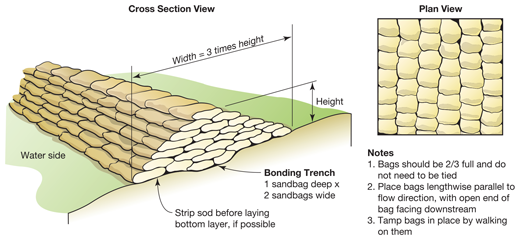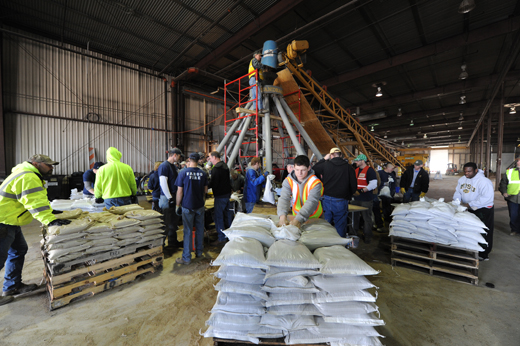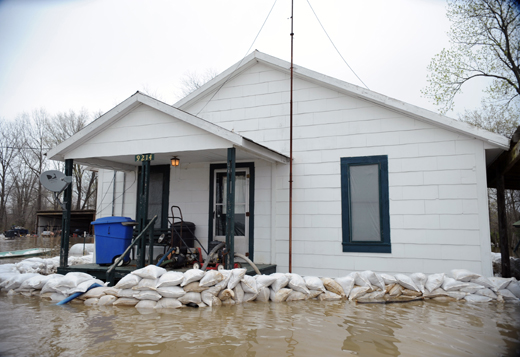Mitigation Strategy
Construct a sandbag barrier
Overview
A sandbag barrier is a temporary barrier made of sandbags that is meant to divert floodwaters away from vulnerable properties. Given proper notice and supplies and trained personnel, sandbag barriers can be constructed to protect an entire structure. With less time, they can be used to make building openings – like doorways, garage doors, and windows – water resistant, or provide additional height to existing permanent flood barriers, such as floodwalls or levee systems. Sandbags should only be used as a last resort as they cannot guarantee a water-tight seal and are not a reliable protection measure.

Filling and stacking sandbags requires time and effort. At least two people are needed to effectively fill and construct a sandbag barrier. On average, it takes two people an hour to fill 100 sandbags to build a barrier that is one-foot tall and 20-feet long. For this reason, they are usually put in place when there is advance notice of a possible flood. In situations where floodwaters rise quickly, it may not be possible to erect an effective sandbag barrier. Additionally, if the sandbags have not been properly filled and placed, the resulting barrier can be knocked over by rising waters.
Communities typically make burlap or plastic sandbags and sand available to residents in the event of a large flood event. Your community should provide information about where you can obtain materials for sandbags. If you purchase your own sandbags, their cost may be covered under your NFIP policy. You will want to make sure that any supplies you use for sandbagging have not been compromised or deteriorated over time.
Sandbag barriers should be removed once the flood danger has passed.
Property Characteristics
Property Scale
Neighborhood
Single Property
Real Estate Type
Single-family residence
Business
Government building
Foundation Type
Slab-on-Grade
Crawlspace
Basement
Property Location
Non-coastal
Past Flood Depth
Shallow
Moderate
Debris Flow Potential
No
Structure Condition
Fair-to-excellent condition
Less than fair condition
Implementation Factors
Annual Maintenance Required
Medium
Action Required If Flood Is Imminent
Yes, Active
Relative Cost
$
$$
$$$
Level of Effort
Professional
DIY

Next Steps:
- Check to see if your local government, flood control district, or other regional or state government agencies have sandbags available.
- Pick up your sandbagging supplies well in advance of a flood event. If not available via your local government, you should be able to purchase sandbag materials from local home improvement stores.
- Fill your sandbags. Note: they should only be filled half to two-thirds of the way full and do not need to be tied. If not tied, the sandbag opening should be folded and placed with the flap underneath the weight of the sandbag; the flap should point towards the oncoming floodwater.
- See the “Flood Fighting: How To Use Sandbags” resource in the additional resources section for instructions on how to place your sandbags to construct an effective barrier.
Special Considerations:
- This mitigation option type is not recommended in areas with high velocity flooding, where water moves at more than 6 feet per second. If you do not know the projected flood velocity around your property, check with your local floodplain manager.
- Be careful how you dispose of sandbags as they may be considered hazardous material due to contamination by floodwaters.
- Be careful not to redirect water flow from your property onto another property. No adverse impact (NAI) floodplain management is an approach that ensures the action of any property owner, public or private, does not adversely impact the property and rights of others. NAI calls for any adverse impact caused by a project to be mitigated as part of the project. By following NAI principles, you can: prevent flooding from increasing or damaging others; see a reduction in flood losses over time; and avoid challenges and lawsuits over causing or aggravating a flood problem.
- Create a disaster plan. Be aware of all actions you will need to take once you receive warning of an oncoming flood event — and how much time each action will take to complete. Actions could include constructing your sandbag barrier or installing flood shields. Annually, inspect all removable pieces to make sure they are in good condition — and you have all necessary parts. Make sure whoever is identified to complete each action in your disaster plan knows how to perform the action, is physically able, and will be onsite. Once everything is in place to protect your home, you should evacuate to higher ground.
- Renters and those who own specific types of property may be limited in which mitigation options they can undertake or have different requirements to which they must adhere. If you are a renter or own any of the following listed property types, click through to learn more: Renter; Unit in a multifamily residence; Manufactured home; Farm/ranch; Historic property; New construction.
Reduce Flood Risk
https://www.reducefloodrisk.org/mitigation/construct-a-sandbag-barrier/
Printed: 05/12/2024







